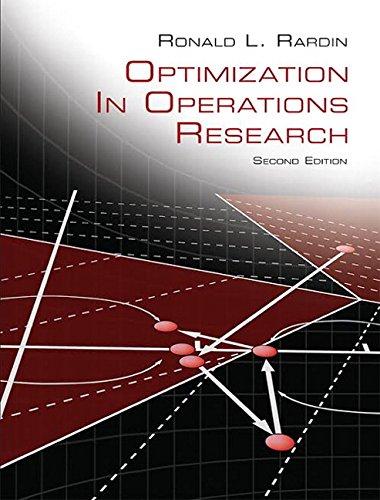The Regional Power Alliance (RPA) is a profit-making operator of electric power generators g = 1,c, G.
Question:
The Regional Power Alliance (RPA) is a profit-making operator of electric power generators g = 1,c, G. Each generator g can be utilized or left idle in any of the t = 1,c, T months over which it plans its operation. If generator g is utilized, there is a fixed setup cost of fg each time, and the power it produces must fall between Wg min and Wg max (in megawatt hours (MWh)), with variable cost of cg per MWh. Decisions about which generators to utilize are made at the beginning of the planning horizon which take into account maintenance and other needs.
RPA planning must address 2 broad markets for its power. The first is “base load” power sold under agreements selected from an available list k = 1,c, K at the beginning of the planning horizon. Such contracts set a price dk per MWh, and requirements to deliver rk,t MWh in periods t. These base load contracts must be accepted or declined on an all-or-nothing basis.
The second “peak load” part of RPA’s sales comes from offering power not committed to base-load customers in short-term energy markets. The difficulty is that there is uncertainty of what selling price vt will be available in the market when period t arrives. To account for this uncertainty, RPA has constructed a series of scenarios s = 1,c, S having probability p1s2 with assumed prices vt 1s2 per MWh in time t.
RPA seeks a production and sales plan to maximize its expected total profit over the planning horizon.
(a) Explain why RPA’s problem can be formulated as a two-stage mixed-integer stochastic program with Stage 1 deciding which generators to utilize and which base-load contracts to adopt, then Stage 2 adding the issue of peak-load power sales in different scenarios.
(b) Justify why the needed decision variables in your model can be defined as xgt ! 1 generator g is operated in period t1=0 otherwise2, yk ! 1 if contract k is accepted 1=0 otherwise22, wgt Ú 0 !
the total power produced (MWh) by generator g in period t, and zt 1s2 Ú 0 ! the amount of power (MWh) sold as peak load in period t under scenario s.
(c) Using the above parameters and decision variables, formulate and justify an expected-
value objective function tracking fixed cost of open generators, plus variable cost of base- and peak-load generation, versus income from fulfilling adopted power agreements, and expected income from sales in the peak-load market.
(d) Using the above parameters and decision variables, formulate and justify a system of constraints requiring total power produced
(both base-load and peak-load markets)
from each open generator g and each period t falls between Wg min and Wg max.
(e) Using the above parameters and decision variables, formulate and justify a system of constraints for each scenario and time period assuring power produced across all open generators fulfills both selected power agreements and peak-load market sales for the scenario.
(f) Complete an extensive-form statement of the full model, including variable-type constraints.
Step by Step Answer:






